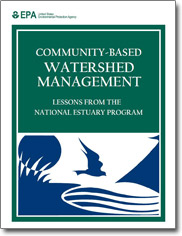The National Estuary Program (NEP) represents a unique partnership of the U.S. Environmental Protection Agency (EPA) and numerous federal, state and local organizations working together to address coastal watershed management challenges.
To share the wealth of knowledge and experiences of the 28 NEPs, EPA developed the Community-Based Watershed Management Handbook. The Handbook describes the highly successful approaches implemented by the NEPs, and while NEPs focus on estuaries and coastal watersheds, their experiences can be adapted to non-coastal watershed initiatives.
Highlighted below are four keys to successful watershed management drawn from the NEP experiences. These elements, and other lessons learned, are further described in the Handbook.
Four Keys to Successful Watershed Management
You may need a PDF reader to view some of the files on this page. See EPA’s About PDF page to learn more.-
Establishing governance structures according to watershed boundaries (PDF)(15 pp, 1 MB)
Because environmental problems do not conform to political jurisdictions, the NEPs define their management areas and management committees according to watershed boundaries and the ecosystems within them.
-
Using science to develop and implement a management plan (PDF)(19 pp, 1 MB)
The NEPs use science to assess estuary conditions, develop solutions to estuary problems and adapt management efforts. They conduct a technical characterization that describes the quality of the estuary, defines its problems and links problems to causes.
-
Fostering collaborative problem solving (PDF)(13 pp, 859 K)
The NEPs invest a considerable amount of time to facilitate consensus on complex environmental issues. They develop mechanisms such as charters, bylaws or memoranda of agreement to provide a framework for resolving conflicts.
-
Informing and involving stakeholders to sustain commitment (PDF)(25 pp, 949 K)
The NEPs inform stakeholders about the estuary and their mission, goals, objectives and progress to ensure their sustained commitment. The NEPs involve stakeholders through such mechanisms as opinion surveys and small group meetings, as well as formal participation on citizen advisory and other committees.

